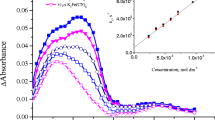Abstract
Introduction
In the nuclear industry 1,4-dioxane is used as a solvent in liquid scintillation technique for measuring low-energy beta-emitters such as 3H or C14 in aqueous media. Improper disposal of 1,4-dioxane can contaminate the ground and surface waters. Conventional wastewater treatment processes like chemical treatment, air stripping, carbon adsorption, and biological treatment are ineffective for the degradation of 1,4-dioxane.
Methods
In the present study, the kinetics of degradation of 1,4-dioxane using advanced oxidation processes viz., H2O2 alone, Fe(II) + H2O2, UV (15 W) + H2O2, UV (15 W) + Fe(II) + H2O2, US (130 KHz) + Fe(II) + H2O2, and sunlight + Fe(II) + H2O2 at pH 3.0 was investigated. The optimization of Fe (II) for the processes using Fe (II) + H2O2 was carried out.
Conclusions
The kinetics of degradation using sunlight + Fe (II) + H2O2 was found to be fastest when compared to the other processes. The degradation was found to follow first-order kinetics. Formation of acidic intermediates was suspected from the observed pH changes during the degradation processes.





Similar content being viewed by others
References
Adams CD, Scanlan PA, Secrist ND (1994) Oxidation and biodegradability enhancement of 1,4-dioxane using hydrogen peroxide and ozone. Environ Sci Technol 28:1812–1818
Adewuyi YG (2001) Sonochemistry: environmental science and engineering applications. Ind Eng Chem Res 40(22):4681–4715
Bandala ER, Pelaez MA, Salgado MJ, Torres L (2008) Degradation of sodium dodecyl sulphate in water using solar driven Fenton-like advanced oxidation processes. J Hazard Mater 151:578–584
Bossmann SH, Oliveros E, Gob S, Siegwart S, Dahlen EO, Payawan I, Straub M, Worner M, Braun AM (1998) New evidence against hydroxyl radicals as reactive intermediates in the thermal and photochemically enhanced Fenton reactions. J Phys Chem 102:5542–5550
Coleman HM, Hon H, Amal R, Leslie G, Wehner M, Fitzsimmons S (2005) Removal of oestrogenic and carcinogenic substances from water using alternative water treatment methods. In: Proceedings of AWA Conference on Contaminants of Concern, Canberra, Australia, 22nd–23rd June
Coleman HM, Vimonses V, Leslie G, Amal R (2007a) Removal of contaminants of concern in water using advanced oxidation technologies. Water Sci Technol 55:301–306
Coleman HM, Vimonses V, Leslie G, Amal R (2007b) Degradation of 1,4-dioxane in water using TiO2 based photocatalytic and H2O2/UV processes. J Hazard Mater 146:496–501
Emilio CA, Jardim WF, Litter MI, Mansilla HDEDTA (2002) Destruction using solar feriioxalate Advanced Oxidation Technology (AOT) comparison with solar-photo-Fenton treatment. J Photochem Photobiol Chem A 151:121–127
Hoigne J, Bader H (1983) Rate constants of reaction with organic compounds in water 1. Non-dissociating organic compounds. Water Res 17:173–183
Howard PH (1990) Solvents: handbook of environmental fate and exposure data for organic chemicals. Lewis Publishers, Michigan, pp 216–221
Huang CP, Dong C, Tang Z (1993) Advanced chemical oxidation: its present role and potential future in hazardous waste treatment. Waste Manag 13:361–377
Kelcka GM, Gonsoir SJ (1986) Removal of 1, 4-dioxane from wastewater. J Hazard Mater 13:161–168
Maurino V, Calza P, Minero C, Pelizetti E, Vincenti M (1997) Light-assisted 1,4-dioxane degradation. Chemosphere 35(11):2675–2688
Nakajima A, Tanaka M, Kameshima Y, Okada K (2004) Sonophotocatalytic destruction of 1,4-dioxane in aqueous systems by HF-treated TiO2 powder. J Photochem Photobiol A 167:75–79
Perez M, Torrades F, Domenech X, Peral J (2002) Fenton and photo-Fenton oxidation of textile effluents. Water Res 36:2703–2710
Pignatello JJ, Liu D, Huston P (1999) Evidence for an additional oxidant in the photoassisted Fenton reaction. Environ Sci Technol 33:1832–1839
Sittig M (ed) (1991) Handbook of toxic and hazardous chemicals and carcinogens. Noyes Publishers, NJ
Son HN, Choi SB, Khan E, Zoh KD (2006) Removal of 1, 4-dioxane from water using sonication: effect of adding oxidants on the degradation kinetics. Water Res 40:692–698
Stefan MI, Bolton JR (1998) Mechanism of the degradation of 1,4-dioxane in dilute aqueous solution using the UV/hydrogen peroxide process. Environ Sci Technol 321:588–1595
Sun Y, Pignattello JJ (1993) Photochemical reactions involved in the total mineralization of 2, 4-D by Fe+3/H2O2/UV. Environ Sci Technol 27:304–310
Vogel AI (1939) Quantitatative inorganic analysis, thirdth edn. Longman publishing, London, p 363
Ware GW (ed) (1988) P-Dioxane in reviews of environmental contamination and technology, 106th edn. Springer, New York, pp 113–121
Yim B, Okuno H, Nishimura N, Maeda Y (2002) Sonolysis of surfactants in aqueous solutions: an accumulation of solute in the interfacial region of the cavitation bubbles. Ultrasonic Sonochem 9(4):209–213
Zhang T, Oyama T, Horikoshi S, Zhao J, Serpone N, Hidaka H (2003) Photocatalytic decomposition of the sodium dodecylbenzenesulphonate surfactant in aqueous titania suspensions exposed to highly concentrated solar radiation and effects of additives. Appl Catal B Environ 42:13–24
Zhao XK, Yang GP, Wang YJ, Gao XC (2003) Photochemical degradation of dimethyl phthalate by Fenton reagent. J Photochem Photobiol A 161:215–220
Zhou H, Smith DW (2001) Advanced technologies in water and wastewater treatment. Can J Civil Eng 28(suppl 1):49–66
Acknowledgments
The authors express their sincere thanks to Mrs. Sharal Sarojini for having assisted in carrying out the experimental work and Sh. TSS Raghavan for technical assistance.
Author information
Authors and Affiliations
Corresponding author
Additional information
Responsible editor: Philippe Garrigues
Rights and permissions
About this article
Cite this article
Chitra, S., Paramasivan, K., Cheralathan, M. et al. Degradation of 1,4-dioxane using advanced oxidation processes. Environ Sci Pollut Res 19, 871–878 (2012). https://doi.org/10.1007/s11356-011-0619-9
Received:
Accepted:
Published:
Issue Date:
DOI: https://doi.org/10.1007/s11356-011-0619-9




